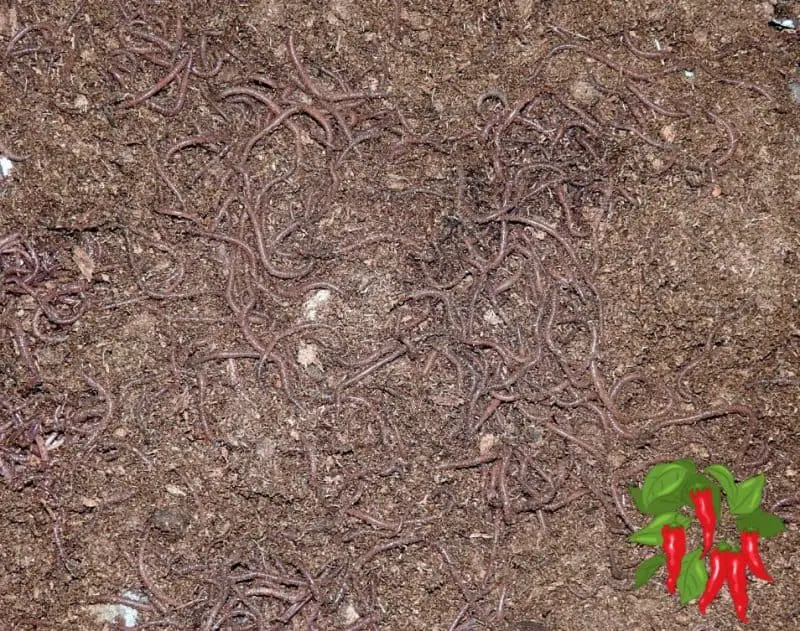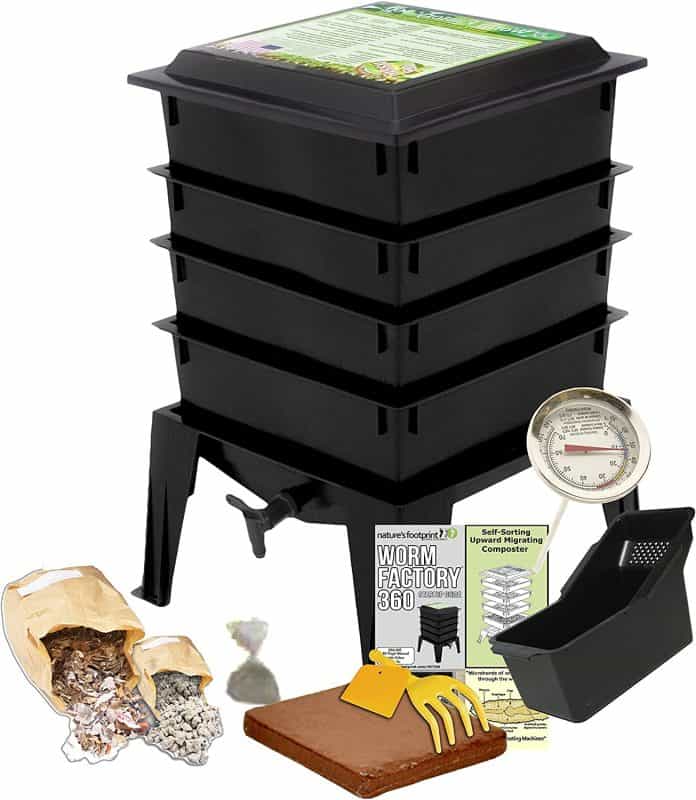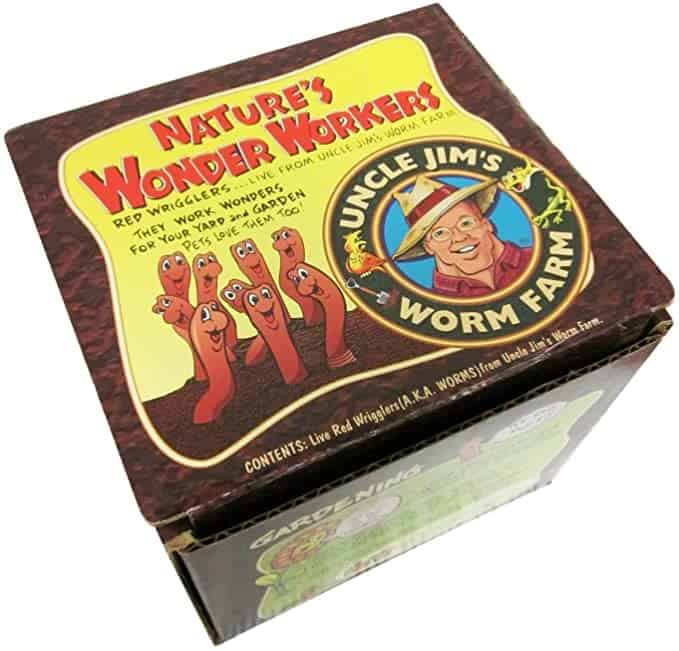This post contains affiliate links. If you buy something from one of our links we may earn a commission. Thanks

Discover the ease of vermicomposting for apartments. Transform your food scraps into valuable compost effortlessly, even in small spaces. Your green journey awaits!
If you live in an apartment, you might be wondering if vermicomposting is even possible. The good news is that it is!
Vermicomposting Key Takeaways:
- Vermicomposting for apartments is a practice where you utilize a small worm bin to recycle organic waste like food scraps into nutrient-rich compost, right in the comfort of your home.
- It requires a container, bedding, worms, and a small space to keep the bin.
- The process helps in reducing waste, improving soil quality, and promoting a sustainable living environment.
Vermicomposting for Apartments
Embarking on the green path of vermicomposting for apartments is not only exciting but also a giant leap toward sustainable living.
If the thought of composting indoors sounds daunting, don’t worry.
Vermicomposting, or worm composting, is a hassle-free way to recycle your kitchen waste into valuable nutrients for your plants.
Whether you have a green thumb or are just starting your sustainability journey, this modest venture of keeping a worm farm in your apartment will surely add a rewarding facet to your eco-conscious lifestyle.
I Just Happen To Live In An Apartment
I am using a Worm Factory 360 in my small apartment. It is very compact at 16 inches square so you can find space for it just about anywhere in your apartment too. Here is my unboxing video.
Worm composting is a great way to reduce your waste output and create nutrient-rich soil amendments for your garden.
In this blog post, we’ll discuss the basics of worm composting in an apartment setting and provide tips for getting started.
One of the great things about worm composting is that it doesn’t take up a lot of space. You can easily set up a worm bin in your kitchen or even under your sink.
How To Build A DIY Worm Compost Bin
All you need is a container, some bedding material, and, of course, worms! Once you have your bin set up, simply add your food scraps to the bin and let the worms do their work.
Sounds easy enough but there’s a bit more to it than that. So keep reading.
Worms need air so if you are building your own worm bin make sure you drill holes around the top. You will also want to drill holes in the bottom for drainage.
A common way to build a DIY worm bin is to use 2 5-gallon buckets one inside the other.
But here is a video about building a DIY worm composter with totes. This video shows how to build a 3 tote system that works much better than using buckets.
This is a good system but I don’t care for the drain valve placement on the bottom of the tote. With inflation, it will cost more than $30 too.
My Worm Factory 360
I really like my worm bin. It is really low maintenance. It has multiple trays and as you feed your worms they eventually fill up.
At that point, you simply add another tray and add food to it. The worms will move up into the new trays you add.
At some point, you will harvest the bottom tray. The beauty of this system is all the worms are higher up in the worm bin.
So you won’t have too much of a job separating out a few stragglers from your finished vermicompost which is now ready to use.
So within a few months, you’ll have nutrient-rich compost to use in your garden.
Setting Up A Worm Bin Some Tips
If you’re interested in worm composting in your apartment, there are a few things to keep in mind especially if you are building one yourself.
If you use the Worm Factory 360 drainage and airflow are already taken care of.
- First, make sure that your bin has adequate drainage so that it doesn’t become too wet.
- Worms need oxygen so drill air holes.
- Worms avoid light so they won’t climb out of them.
- Second, be sure to add a variety of food scraps to your bin for the worms to eat.
- And finally, keep an eye on your bin and make sure that it’s not getting too hot or too cold.
With a little bit of care, you can easily vermicompost in your apartment and reduce your environmental footprint.
Plus, you get the added benefit of worm castings (composted manure) which are great for your plants.
Here are some more tips for indoor worm composting:
Adding vermicomposting to your gardening routine is a great way to reduce your food waste and give your plants a boost.
If I haven’t scared you off yet and you’re still interested in vermicomposting, here are a few more tips to get you started:
- Choose the right container. You’ll need a bin that’s big enough for your worms, has good drainage, and is made of breathable material (like plastic or wood).
- Avoid using metal or glass containers, as they can get too hot or cold for your worms.
- Add bedding material. This can be anything from shredded newspaper to chopped-up straw but I prefer coco coir.
- The bedding should be moist, but not wet.
- Add your worms. Red wigglers are the best type of worm for vermicomposting, don’t use earthworms.
- Start with about one pound of worms for every two to three pounds of food scraps you have.
- Feed your worms. Give them a variety of organic materials, such as fruit and vegetable scraps, coffee grounds, eggshells, and shredded paper.
- Worms will also eat paper and cardboard so they are great for getting rid of your junk mail.
- Avoid meat or dairy products, as they can attract pests or create unpleasant odors.
- Keep your bin warm and moist. Worms prefer temperatures between 55 and 77 degrees Fahrenheit. If it becomes too hot or cold, your worms will die.
Vermicomposting for Apartments Tips
You can buy commercial worm bins or make your own out of plastic storage containers.
As to adding bedding material. Coco coir makes the best bedding material but you can use shredded newspaper too.
Red wigglers are the best type of worm for vermicomposting don’t use earthworms they are a different species. They won’t do well in a worm compost bin.
Start with about 500-1000 worms.
Worms will eat their weight in food scraps every day. They are self-regulating and reproduce easily as long as food is available.
Don’t collect them outdoors in your garden because earthworms are different than composting worms and won’t do well in a small bin.
If you have access to a manure pile you might be able to find red wigglers for free but they may not be as healthy as those from a worm farm.
You can add some kitchen scraps to the bedding material to help get things started, but avoid adding too much at once or you risk overwhelming the worms.
As your worm bin fills up with compost, you’ll need to add more bedding material to keep the worms comfortable.
Once the bin is full, you can start removing finished compost from the bottom and using it in your garden or houseplants.
How To Use Worm Castings
Vermicompost is a nutrient-rich organic fertilizer made from composted organic matter that has been through the digestive system of your worms.
This product is often called worm castings. If you look in a garden center you will find this is an expensive product that is sometimes called black gold.
Worm castings can be used to fertilize both outdoor and indoor plants and have a variety of benefits.
Using vermicompost on indoor plants can help improve drainage, aeration, and water retention in potting soil.
Additionally, it can provide a slow release of nutrients to your plants and help reduce the need for chemical fertilizers.
No Room Outdoors? No Problem
If you’re interested in vermicomposting but don’t have the space for an outdoor bin, don’t worry! You can still vermicompost indoors.
I know it seems like I am repeating myself but I really want to make sure you succeed at worm composting in case you missed something.
Here are some tips on how to vermicompost in an apartment:
- Choose a small, lidded plastic container for your indoor worm compost bin. A storage tote or Rubbermaid container works well. Drill holes in the lid for ventilation.
- Fill your bin with bedding material such as shredded newspaper, Coco coir, or worm castings. Moisten the bedding until it is damp but not soggy.
- Add worms to your bin. Red wigglers are the best type of worm for indoor composting because they can tolerate a wider range of temperatures and moisture levels.
- Feed your worms food scraps such as fruit and vegetable peels, coffee grounds, and eggshells. Avoid meat, dairy, or oily foods.
- Keep your bin in a cool, dark place. A closet or basement works well.
- Check on your bin every week or so to make sure the bedding is damp and the worms are healthy. Add more bedding or food scraps as needed.
What Are The Benefits Of Vermicomposting?
The benefits of vermicomposting are many, but here are a few of the most important ones:
- Vermicomposting reduces the amount of organic waste that goes into landfills.
- Vermicomposting helps to improve soil quality by adding beneficial microbes and nutrients.
- Vermicompost can be used as a natural fertilizer for plants.
- Vermicomposting can help to reduce greenhouse gas emissions from decomposing organic matter.
Overall, vermicomposting is a great way to reduce your impact on the environment and help your garden or houseplants thrive.
If you’re looking for a way to cut down on food waste and be more sustainable, vermicomposting is a great option.
Is Vermicomposting Worth It?
Absolutely! Not only does it reduce the amount of organic waste that goes into landfills, but it also helps to improve soil quality and can be used as a natural fertilizer for plants.
If you’re looking for a way to be more sustainable, vermicomposting is a great option. Give it a try today! You may be surprised at how easy and rewarding it is.
What Is A Worm Bin?
There are a lot of different ways to vermicompost, but one of the most popular methods is using a worm bin.
A worm bin is simply a container that houses worms and their food scraps. The worms eat the food scraps and turn them into nutrient-rich compost.
Worm bins are great for apartments because they don’t take up a lot of space.
The Worm Factory 360 is a popular option for indoor worm composting.
It’s a stackable, modular system that can be easily expanded as your needs change.
If you’re interested in starting a worm bin, there are a few things you need to know.
First, you’ll need to find a good location for your bin. It should be in a cool, dark place where the temperature will remain consistent. A basement or closet is usually a good option.
Next, you’ll need to gather some supplies. You’ll need a bin (like the Worm Factory 360), bedding material (like shredded newspaper or coconut coir), and food scraps.
Once you have everything you need, it’s time to set up your bin!
Don’t forget to order your worms. You can buy them here
Here are some tips for setting up and maintaining your Worm Farm 360:
If you’re interested in vermicomposting but don’t have a lot of space, the Worm Factory 360 is a great option.
This unit is designed for small spaces and can be used indoors, making it perfect for apartment dwellers.
Indoor Worm Composting Bin Worm Factory 360 (indoorvegetablegrower.com)
The Worm Factory has a really good guide to using it. I suggest you read it!
Here are some tips for using a Worm Factory 360 and getting started with indoor worm composting:
- Choose a location for your Worm Factory 360 that is out of the way but still accessible.
- You’ll need to empty the unit every few months, so you’ll want to be able to reach it easily.
- You won’t need a tray to prevent any leaks because the Worm Factory has one and also has a spigot to drain off your leachate.
- Add bedding material to the unit. The Worm Factory comes with coco for bedding material. I think coco is best for this
- But I don’t think they give you enough so be prepared to buy some extra coco coir. Coco bricks are easy to store and rehydrate easily.
- Moisten the bedding before adding worms.
- Always use red wigglers.
- Add food scraps to the unit on a regular basis.
- Avoid adding meat, bones, or dairy products, as these can smell and attract pests.
- Empty the unit every few months and use the compost in your garden or houseplants.
Worm Composting FAQs
The world of vermicomposting or worm farming can spark numerous questions especially when dwelling in an apartment.
From selecting the right kind of worms to understanding the dos and don’ts of feeding them, the queries are endless.
This FAQ section is crafted to provide a deeper insight into making vermicomposting in apartments a smooth sail.
Let’s dive into some common questions and unravel the mysteries of indoor worm composting together.
Q. What type of container is suitable for vermicomposting in an apartment?
A. Choose a small, lidded plastic container like a storage tote or Rubbermaid container. Ensure it has good drainage and ventilation by drilling holes in the lid and bottom.
Q. What kind of worms are best for vermicomposting?
A. Red wigglers are the best choice for vermicomposting. They adapt well to the bin environment and efficiently process the organic material into compost.
Q. What should I feed the worms in my vermicomposting bin?
A. Feed your worms organic material like fruit and vegetable peels, coffee grounds, eggshells, and shredded paper. Avoid meat, dairy, or oily foods as they can attract pests and create odors.
Q. How do I maintain the right environment in my vermicomposting bin?
A. Keep your bin in a cool, dark place with a consistent temperature between 55 and 77 degrees Fahrenheit.
Ensure the bedding is damp, and not soggy, and check on your bin weekly to maintain a healthy environment for your worms.
These responses cover the initial steps and considerations to kickstart your vermicomposting adventure in your apartment, making the process straightforward and enjoyable!
Final Thoughts: How do you vermicompost in an apartment?
In conclusion, vermicomposting is a great way to reduce your impact on the environment and help your garden or houseplants thrive.
If you’re looking for a way to cut down on food waste and be more sustainable, vermicomposting is a great option.
You may be surprised at how easy and rewarding it is. With a little effort, you can easily start vermicomposting in your apartment!
I have included a video that shows how to build a 3 tote worm bin. If you are not the DIY type or short on time the Worm Factory 360 is just the ticket for you.
Give vermicomposting in your apartment a try today! Here is some more info on how to start worm composting.







